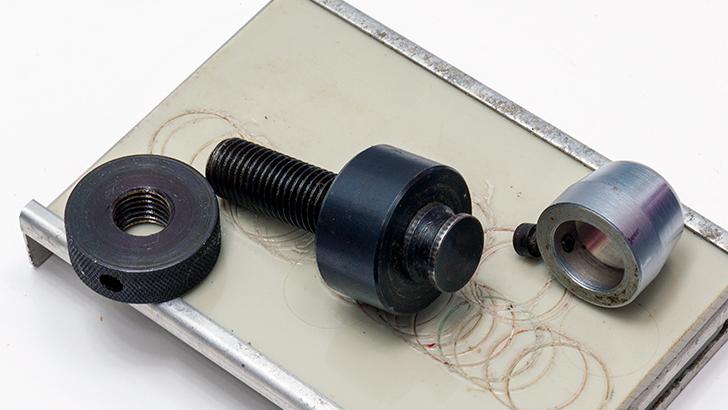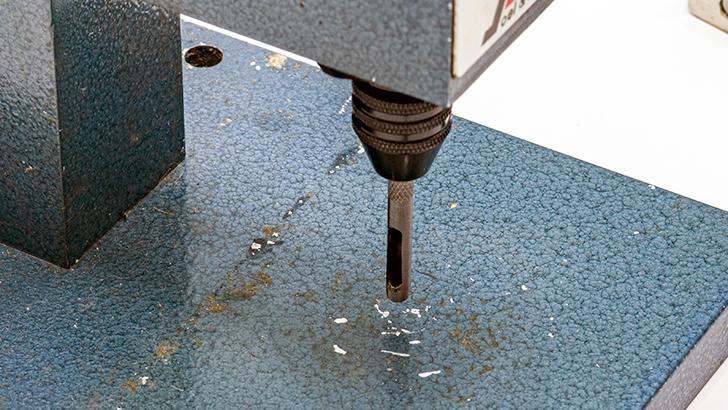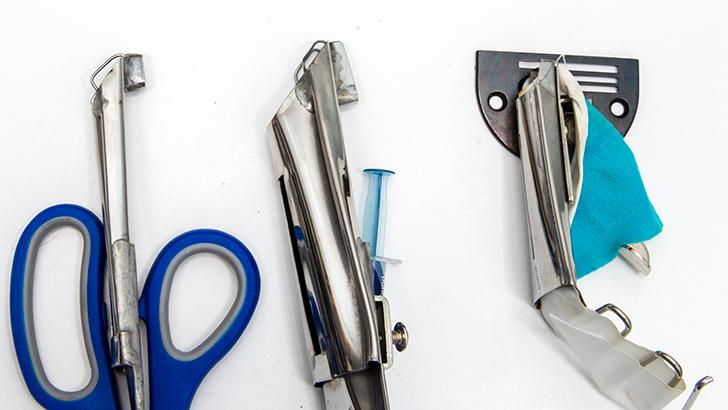
kgg
Contributing Member-
Posts
3,273 -
Joined
-
Last visited
Content Type
Profiles
Forums
Events
Blogs
Gallery
Everything posted by kgg
-
Interesting the speed difference between the two machines using the same motor and same size handwheel. kgg
-
Thank you dikman. I am working on strap folder using a free domestic sewing machine motor, we'll see how that goes. Proprietary threading is a way but if they really wanted to have a custom thread they should have used a left hand 13 twist to really fool with customers. Sort of remains me of Singer threading. kgg
-
That is nice work. kgg
-
I came across a table mounted fabric hole press at auction for about $25 made by Joel & Aronoff called "The J & A Patch Press" which I believe are made at some point in England. All it needed was a little cleaning and some oil. Having a fabric hole press wasn't what I wanted, it had to do more. I only need a press to do two simple things i) accurately punch holes for rivets and ii) press my logo into leather. The main problem I came across while doing this little conversion was the 5/8 " punch bolt and internal threaded rod. The round nut, punch bolt and the internal threaded rod have an unusual thread twist of 13. Normally I would have printed a 5/8 x 11 or 12 or 14 and run a die over to clean up the thread. Noooo, not this one it was a 5/8 x13 or maybe a even 13.25 which I confirmed with a thread gauge. That sent me down the rabbit hole of designing a 5/8 x 13 thread. A proper die would have be very costly at around $400 while my time is cheap. You got to love priority threads. Even through it has a small travel of 16mm it does work for what I need. This may give others an idea of converting other equipment to do other things that it wasn't designed for. Photo 1: Shows how it came, with a Aluminum 24.6 mm, another odd size, hole punch. Photo 2: Shows the pieces that screw the three punch parts into a thread rod in the press head. I place the parts on the HDPE pad that came with the press. The round nut is use to set / lock the travel of the punch bolt while the punch is held in place on the bolt with a simple set screw that fits into a hollow formed at the head of the punch bolt. Photo 3: Shows my 3D printed logo using the original punch bolt using and using a simple set screw attachment like the hole punch has. Photo 4: Shows my 3D printed logo which I made in two parts so I can change to different imprinting attachments at latter date. Photo 5: Shows the hollow hole punch that I cut down set in a mini chuck that has a 3D printed adapter so it can be screwed into the internal threaded rod. Photo 6: Shows the cut down punch, the mini chuck and the adapter that the mini chuck screws into (3/8" X 24) and also screws into the internal threaded rod (5/8" X13). Photo 7. Hole punched in approximately 4 oz, logo without any damping and a logo with slight damping applied to the leather.
-
Looks to me like it was done using a machine. I guess they used their hands to guide it through a machine and the pieces were sewn together so... " Hand Sewn ". Hopefully this type of item doesn't fool many people. kgg
-
I wouldn't consider buying the machine mainly as replacement parts are going to be expensive. I would look for something from a dealer either a new or refurbished machine. Either way they can help with the machine setup for your needs. To me this machine sounds like it was bought as a quick flip and/or has other hidden problems. kgg
-
Also you may want to view the topic and discussion around a new Consew servo motor ------ "Need Help with new Servo Motor install and Needle Positioner " kgg
-
A lot of people find the needle positioner good but.... but not all are equal or work properly with all combinations of digital servo motors. If you are considering a needle positioner buy the complete setup (motor / speed reducer / needle positioner) all at one time from a company that have a proven combination setup. As far as servo motors you basically got two options i) a good old fashion proven brush servo motor with a small knob speed dial or ii) a digital controlled brush-less servo motor. One of the problems with the digital servo motors is the number of internal coils that the motor is constructed with. The more coils the better the control and torque for the motor. I suspect the cheaper ones have 6 or maybe 9 coils. A good 12 coil digital servo motor would be similar to the Reliable Sewquiet (www.reliablecorporation.com/products/sewquiet-6000sm-servomotor ) or the Sailrite clone. My thought is for most use, a brush servo motor if it is properly broken in under no load, should provide a lot of decent reliable service. I have this type on three of my machines Juki 1181n, Juki 1541 S and Kobe LS -1341 (Juki 341 clone). kgg
-
Highlead Walking Foot Cylinder Arm GC2698-GC - Good for binding?
kgg replied to Gulrok's topic in Leather Sewing Machines
If it is like other 335 class machines you will be limited to either V69 or V92 thread. kgg -
Need help threading Brother machine
kgg replied to rivercityleather's topic in Leather Sewing Machines
Looking at the photo again I agree the back very well may have be hacked off as well. I hope they didn't spend much for the machine. kgg -
Need help threading Brother machine
kgg replied to rivercityleather's topic in Leather Sewing Machines
What I see from your photo: Threading: i) The first double hole top thread guide pin which probably sits in the hole in the top of the machine located just behind and above the letter "t" in brother. ii) Don't see a thread thread take-up arm, maybe just the angle with the sewing light hiding it. iii) Top Thread Take-up arm is missing the protective arm that prevents things like you light from striking the take-up arm as it cycles through it's sewing cycle iv) Top Thread Guide just before the needle is missing v) The Front Bobbin Cover (nose) is missing. Structural: i) The machine appears to have received a serve knock that removed the front left corner of the base. ii) The machines appears to have had a very heavy coat of paint applied. This maybe covering structural cracks. iii) Top Belt Pulley maybe not original? Identification: i) Your machine looks very similar to a Taking TK-335 so the following video ( www.youtube.com/watch?v=t52VC4KCZpM )should help you with threading and missing pieces. If it is a 335 class machine you will probably be limited to V92 thread. ii) The model nameplate is missing. Do you know what model it is??? hope this helps kgg -
I agree particularly bobbins as they sometimes are not balanced but usually the center shaft can be either to small or to large. I have seen some bobbins so bad that when you try to wind thread on them they actually wobble on the winder so you can imagine what they are doing when inserted. kgg
-
Pretty good use for the holster since they normally don't carry side arms. kgg
-
I think this is very ingenious, a true "KISS" solution. Yes, this could be done on a 3d printer or laser but I like the simplicity of your solution. Even through I have multi 3d printers, which I dearly enjoy using, your solution for a one of or so is a good practical low cost solution that anyone could do. Not everyone wants to invest the time, money, effort or can afford the investment into more complicated solutions. kgg
-
Having insurance is either a waste of money or a savior. If you never have a problem the insurance premiums were like flushing good money down the toilet but God forbid any goes wrong it can save you and your family from being financially ruined. Just like insuring your home you get replacement house / belongings insurance. Hopefully you never need it but if something like a total loss happens you will be covered. That I can speak of from personal experience. kgg
-
Have you tried stopping the machine so the awl is still buried while the pressor foot is just off the leather. At that point you should be able to turn the leather 90 degrees and continue sewing. kgg
-
Consew 206RB-5: Not picking up bobbin thread
kgg replied to MtlBiker's topic in Leather Sewing Machines
I think this video around the 52 minute mark should help you with moving the hook assembly forward, set screws and timing the "Consew 206RB 5 Maintenance Video Part 1" (youtube.com/watch?v=y4ACNMX65zE). kgg -
Consew 206RB-5: Not picking up bobbin thread
kgg replied to MtlBiker's topic in Leather Sewing Machines
I looked at your video and agree with Constabulary that the hooks to far away from the scarf. I figure you have either a damaged hook like the tip missing or the rotatory hook assembly moved away from the needle as a result of a needle overload, strike or the abrupt kicking in of the clutch. I would check and see if the hook assembly set screw has become loose on the shaft. I would reposition the hook assembly forward on the shaft and re time. kgg -
Consew 206RB-5: Not picking up bobbin thread
kgg replied to MtlBiker's topic in Leather Sewing Machines
Yes it could be but I would suspect that since you are having this problem with the bobbin popping out more often that it has more to do with the mechanism that keeps the bobbin case in place is worn or misaligned. I would check out the video on "How to fix a Juki DNU-1541S that is jammed or stuck" ( youtube.com/watch?v=6PGPtkjsqus&t=68s ) even through it is for a Juki it may help you see how the bobbin assembly is kept in place for your machine. Also it could be as simple as when replacing the needle in a hurry it wasn't installed all the in or backwards. Done that a couple times. kgg -
I am going to assume you mean the little off colored white felt pad in the thread guide located after the thread take-up arm and just before the needle. A lot of machines have what you call an "oil pad". My opinion is that this felt pad is to maintain correct top thread tension and correct top thread routing while the take-up arm cycles up / down. The top thread is sandwiched behind not through the felt pad and the machines body. It is probably a good place to very lightly lubricate the top thread with a little silicon spray for certain incidents of sewing tough, thick or sticky stuff to help the thread slide through the material easier and reduce heating as well this pad helps remove and small particles of loose thread that maybe on the thread from the manufacturing process. This felt pad is not meant to be a sewing machine oiling station for the top thread under normal sewing conditions. I have never needed to lube this felt pad for my type of sewing on my machines. kgg
-
The most important thing I find is how close you can get to the needle without having the pressor foot touch and the proper back tension being applied to the binding tape. Personally, I prefer the inline binders over the 90 degree binders which I think has more to do with personal preference rather then performance and of course cost is always a factor. kgg
-
To you visualize the 1/2" long exit fold that is at 90 degrees to the binder tip and another alternative using a 90 binder mounted to a feed dog cover-plate. The one mounted to the plate hasn't got a 90 exit piece as it can be set really close to the needle. This may give you some idea's. kgg
-
This is the problem with the style of binder you are using on the flatbed. The 90 degree binder is more suited to the cylinder arm machines. I find using the cheap inline binders much better as you can get the exit part of the binder to just about touching the pressor foot to stop binder tape run away. I even built an adapter for my cylinder bed to accept the inline binders. I'm cheap and why have to styles of binders. An option if you really want to use an 90 degree binder is to find one that has a 1/2" long exit fold that is at 90 degrees to the binder tip. That will allow you to get it closer to the pressor foot. kgg
-
Depends on a couple of things. If your drive motor is a clutch motor or a servo motor also whether the sewing machine is a upholstery class machine or a 441 class machine. Clutch Motors: i) Are always running at their top speed which is typically either 1725 rpm or 3450 rpm and use a clutch to transfer the power to the drive belt. ii) Have a steep learning curve to get use to feathering the clutch to get the proper sewing speed. iii) Noisy since there is always a humming noise when the motor is powered. iv) Energy inefficient. Servo Motors: i) Only consumes about 75 percent what would be required to power a clutch motor when running. Since the motor isn't consuming energy when not running it probably works out to be closer to 90 percent less energy consumed for the same amount of sewing. ii) More available low end torque. iii) Quiet more like a domestic sewing machine. The noise difference would be like that of standing alongside of gasoline car verse a diesel truck. kgg
-
I forgot to mention that you need to be care that you do not let you pressor foot ride onto the zippers teeth otherwise use a zipper foot. It will mostly depend on the size of the zipper tape and the size of your pressor foot as well as where you need the seam. kgg









